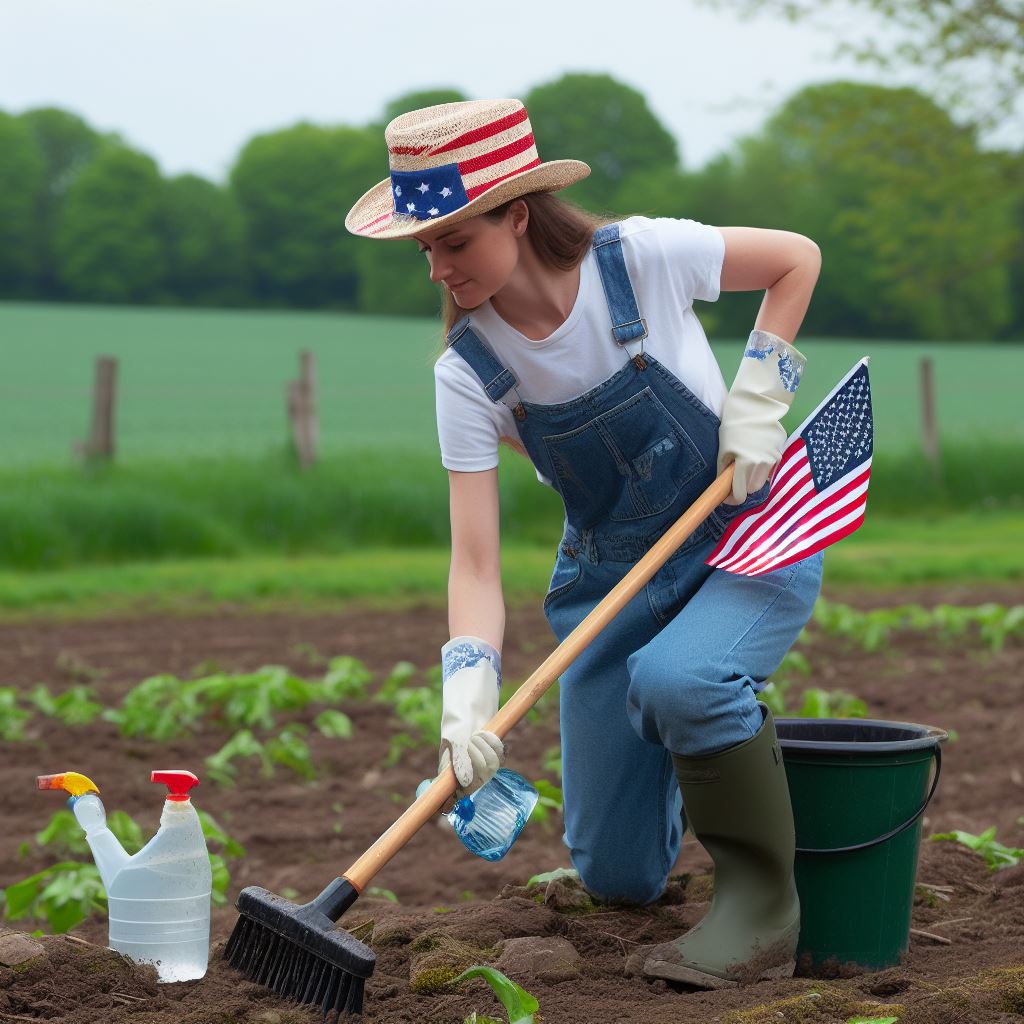Climate Change: A Real Threat to Global Farming
Last Updated on March 2, 2024
Introduction
Climate Change refers to long-term alterations in temperature, precipitation, and wind patterns, among other factors.
It poses a significant threat to global farming, affecting crop yields, livestock production, and agricultural practices.
The impact of climate change on global farming is far-reaching, with the potential to disrupt food security and agricultural livelihoods worldwide.
Changes in temperature and rainfall patterns can lead to droughts, floods, and extreme weather events, all of which can directly harm crops and livestock.
Increasing temperatures can affect crop growth by altering photosynthesis and increasing evaporation rates, leading to water stress and reduced yields.
Rising temperatures also contribute to the spread of pests and diseases, which can destroy crops and lower productivity.
Moreover, changes in precipitation patterns can result in water scarcity or excessive rainfall, both of which can harm crop growth.
Droughts can cause soil degradation and reduce water availability, while heavy rainfall can lead to soil erosion and flood damage.
Climate Change Threat to Global Farming.
Farmers may need to modify planting and harvesting schedules, change irrigation methods, or invest in new technologies to adapt to changing conditions.
Furthermore, extreme weather events can damage agricultural infrastructure like irrigation systems, storage facilities, and transportation networks.
In short, climate change poses a real and significant threat to global farming.
Addressing this issue is crucial to ensuring food security and maintaining sustainable agricultural practices in the face of changing climate conditions.
Impacts of Climate Change on Global Farming
Changing weather patterns
- Climate change is causing significant shifts in weather patterns around the world.
- These changes include irregular rainfall, prolonged droughts, and unexpected frost.
- Such unpredictable weather can disrupt planting and harvest schedules, leading to lower crop yields.
Increased frequency and intensity of extreme weather events
- Extreme weather events like hurricanes, floods, and heatwaves are becoming more frequent and intense.
- These events can devastate crops, destroy infrastructure, and displace farming communities.
- Farmers are struggling to adapt to these extreme weather conditions, impacting their livelihoods.
Shifts in temperature and growing seasons
- Climate change is causing shifts in global temperature patterns and the length of growing seasons.
- Some areas are experiencing warmer temperatures, leading to earlier spring planting and longer harvest periods.
- Other regions are facing colder temperatures, resulting in shorter growing seasons and increased frost damage.
Changes in precipitation patterns
- Climate change is altering the distribution and intensity of rainfall across different regions.
- Some areas are experiencing heavier rainfall, leading to soil erosion and flooding.
- Others are facing prolonged dry spells, making farming more challenging and increasing the risk of wildfires.
Rising sea levels and coastal farming
- The rise in sea levels due to climate change poses a significant threat to coastal farming communities.
- As sea levels rise, saltwater intrusion contaminates freshwater sources, making irrigation difficult.
- Coastal farmlands are also at risk of being flooded, leading to the loss of valuable agricultural land.
Overall, climate change is a real and urgent threat to global farming.
These impacts pose significant challenges to food security, farmer livelihoods, and the global economy.
Addressing climate change and finding sustainable solutions is crucial to ensuring the future of agriculture.
Read: Container Gardening: Ideal for Small Areas
Effects on Crop Production
Reduced productivity and yield losses
Climate change poses a significant threat to global farming, particularly regarding crop production.
One of the major consequences is reduced productivity, leading to yield losses.
This is mainly due to the unpredictable and extreme weather conditions caused by climate change, such as droughts, heatwaves, and heavy rainfall.
These extreme events can damage crops, hinder their growth, and result in decreased yields.
The negative impact is compounded by the increasing frequency and intensity of such weather patterns.
Moreover, rising temperatures can disrupt the delicate balance required for optimal crop development.
Warmer temperatures can accelerate the rate of crop growth, leading to a shortened lifespan and reduced yields.
Conversely, cold snaps or frost can cause damage to crops, killing off vulnerable plants and reducing overall productivity.
Changes in crop suitability and adaptation challenges
Climate change also brings about changes in the suitability of certain crops and poses adaptation challenges for farmers.
As temperatures rise, certain crops may no longer be able to thrive in their traditional growing regions.
This necessitates the cultivation of more heat-tolerant varieties or the exploration of alternative crops altogether.
Farmers are then faced with the task of adapting their practices and finding suitable replacements for the crops that are no longer viable.
This transition can be time-consuming and costly, as new varieties may require different cultivation techniques, equipment, and infrastructure.
Furthermore, adaptation challenges are compounded by the fact that climate change affects different regions differently.
Each region has its own unique set of crops and agricultural practices, making it challenging to establish universal adaptation strategies.
Increased prevalence of pests and diseases
Climate change also leads to an increased prevalence of pests and diseases, which pose additional threats to global farming.
Warmer temperatures and changes in precipitation patterns create favorable conditions for the reproduction and spread of pests and diseases.
Pests, such as insects and invasive species, can multiply rapidly and infest crops, causing significant damage.
Similarly, diseases that affect plants thrive in warmer and wetter conditions, leading to higher infection rates.
Farmers are forced to implement pest management strategies, such as increased pesticide use, to mitigate the impact of these pests and diseases.
However, excessive pesticide use can have detrimental effects on the environment and human health.
Therefore, finding sustainable and integrated pest management approaches is crucial for preserving crop production.
Water stress and irrigation challenges
Climate change exacerbates water stress and poses significant challenges for irrigation in agricultural practices.
Changing precipitation patterns, including increased frequency and intensity of droughts, result in reduced water availability.
Farmers who rely on rainwater for irrigation face difficulties in meeting the water demands of their crops.
As a result, they may have to rely more heavily on irrigation systems, which can further deplete water resources.
However, implementing effective irrigation systems requires both financial resources and technological infrastructure, making it challenging for many farmers.
Water stress also affects crop growth and development, leading to decreased yields and quality.
Additionally, excessive water use in agriculture contributes to the depletion of water sources, exacerbating water scarcity concerns.
Crop diversity and food security implications
Lastly, climate change poses implications for crop diversity and food security on a global scale.
Many regions rely heavily on a small number of staple crops, making them vulnerable to climate-related disruptions.
As certain crops become less suitable for cultivation, there is a risk of losing crop diversity.
Reduced crop diversity can undermine food security, as it limits the availability of nutritious and varied food options.
Moreover, climate change-induced crop failures can lead to food shortages and price increases, affecting the most vulnerable populations.
Ensuring sustainable agricultural practices and promoting crop diversity is crucial to enhance resilience and mitigate the impacts of climate change on food security.
In essence, climate change poses a real and significant threat to global farming, particularly concerning crop production.
The effects include reduced productivity and yield losses, changes in crop suitability, increased prevalence of pests and diseases, water stress and irrigation challenges, as well as implications for crop diversity and food security.
To address these challenges, innovative and sustainable agricultural practices, as well as adaptation strategies, are crucial in securing global food production.
Read: Gardening Tools: Must-Haves for Beginners

Livestock Farming and Climate Change
Impacts on animal health and welfare
- Extreme weather events like heatwaves and hurricanes can cause stress and sickness to livestock.
- Higher temperatures can lead to reduced feed intake, weight loss, and lower reproductive performance.
- Changes in rainfall patterns can affect grazing land quality and availability of water sources.
- Water scarcity and droughts can result in dehydration and malnutrition among livestock, leading to higher mortality rates.
- Increased prevalence of diseases due to favorable conditions for pathogens and vectors.
- Challenges in providing proper shelter, ventilation, and temperature control for animals in extreme weather conditions.
Changes in grazing patterns and availability
- Climate change can alter the availability and quality of grazing land, affecting the productivity of livestock.
- Shifts in rainfall patterns may cause grasslands to dry up, reducing grazing options for livestock.
- Intense rainfall events can lead to soil erosion and degradation, affecting the regrowth of vegetation.
- Changing temperatures can disrupt the seasonal growth patterns of forage plants, making it difficult for livestock to find suitable food sources.
- Migration of grazing animals to different regions due to changing climate conditions, affecting local ecosystems.
Altered feed availability and quality
- Changes in temperature and rainfall patterns can impact crop production, leading to feed shortages for livestock.
- Droughts can result in the failure of crops, reducing the availability of key feed sources for animals.
- Invasive species and pests may thrive in warmer climates, causing damage to crops used for animal feed.
- Higher temperatures can affect nutrient composition in plants, reducing their nutritional value for livestock.
- Limited access to diverse grazing and forage options can lead to imbalanced diets for livestock.
Increased vulnerability to diseases
- Warmer temperatures can facilitate the proliferation and spread of infectious diseases among livestock.
- Changes in rainfall patterns and humidity levels can create suitable conditions for disease-carrying vectors.
- Climatic stress weakens the immune system of animals, making them more susceptible to diseases.
- Existing diseases may become more virulent or spread to new areas due to altered climatic conditions.
- Reduced availability and quality of veterinary services in regions affected by climate change.
Loss of genetic diversity in livestock
- Climate change can lead to the loss of breeds adapted to specific environmental conditions.
- Higher temperatures and extreme weather events can negatively impact reproductive capabilities in livestock.
- Migration patterns of livestock may result in crossbreeding that dilutes genetic diversity.
- Loss of indigenous livestock breeds can lead to a decline in valuable genetic traits and adaptability.
- Genetic uniformity in livestock populations makes them more vulnerable to diseases and environmental changes.
Read: Sustainable Practices for Small Farms
Water Management and Climate Change
Impact on water availability and quality
- Climate change poses a significant threat to both the availability and quality of water resources.
- Rising global temperatures lead to increased evaporation rates, reducing water availability in many regions.
- Extreme weather events such as droughts and floods result in water scarcity and contamination issues.
- These changes in water availability and quality have a direct impact on global farming practices.
Changes in hydrological cycles and water scarcity
- Climate change disrupts the natural hydrological cycles, exacerbating water scarcity around the world.
- Higher temperatures accelerate evaporation, leading to less water being available for crop irrigation.
- Unpredictable precipitation patterns further worsen water scarcity, affecting crop growth and yield.
- Farmers must adapt their water management strategies to cope with these changing hydrological cycles.
Importance of efficient irrigation and water-saving practices
- In the face of climate change, efficient irrigation practices become crucial for sustainable farming.
- Adopting technologies like drip irrigation helps deliver water directly to plant roots, reducing water wastage.
- Other techniques like mulching, rainwater harvesting, and precision farming also promote water conservation.
- Implementing these water-saving practices will ensure the longevity of global farming systems.
Adaptation strategies for efficient water management
To mitigate the effects of climate change on water resources, adaptation strategies are essential.
Investing in water infrastructure, such as dams and reservoirs, helps manage water availability during dry periods.
Promoting water-efficient crops and cultivating drought-tolerant varieties can enhance water management.
Educating farmers about sustainable water practices empowers them to cope with changing climatic conditions.
Collaboration between governments, researchers, and farmers is crucial for successful water management adaptation.
basically, climate change poses a real threat to global farming through its impact on water availability and quality.
Changes in hydrological cycles and water scarcity require farmers to implement efficient irrigation and water-saving techniques.
Adaptation strategies, including infrastructure investment and promoting water-efficient practices, can help manage water resources effectively.
Addressing these challenges through concerted efforts will ensure the resilience of global farming systems in the face of climate change.
Read: Beekeeping: Boosting Your Garden’s Health
Challenges and Opportunities for Sustainable Farming
Strengthening resilience and adaptive capacity
- Farmers must develop the ability to cope with and recover from climate-related shocks and stresses.
- Enhancing farmers’ knowledge and skills in adapting to changing climatic conditions is crucial.
- Building resilient agricultural systems can help minimize the impact of climate change on farming.
Implementing climate-smart agricultural practices
- Adopting climate-smart practices like conservation agriculture and agroforestry can improve farm productivity.
- Precision farming techniques and use of climate-resilient crop varieties can optimize resource use and reduce risks.
- Integrated pest management and efficient irrigation methods contribute to climate change adaptation in agriculture.
Promotion of sustainable land management techniques
- Adopting sustainable land management practices, such as contour plowing and terracing, helps prevent soil erosion.
- Conservation tillage and cover cropping promote soil health and reduce greenhouse gas emissions.
- Restoring degraded lands and protecting biodiversity ensure long-term agricultural sustainability.
Innovations and technologies for climate resilience
- Investing in research and development of climate-resilient crops and livestock breeds is essential.
- Precision agriculture technologies, including remote sensing and drones, provide real-time data for effective farm management.
- Greenhouse gas mitigation technologies, like anaerobic digesters and renewable energy, contribute to climate resilience.
Policy support and funding for climate change adaptation in agriculture
- Governments need to develop supportive policies that prioritize climate change adaptation in the agricultural sector.
- Financial support, grants, and subsidies can help farmers adopt climate-smart practices and invest in resilient infrastructure.
- Collaboration between government, private sector, and farmers’ organizations is vital to secure funding and implement effective solutions.
Climate change poses significant challenges to global farming.
However, there are various opportunities and strategies available for sustainable farming.
Strengthening resilience, implementing climate-smart practices, promoting sustainable land management, embracing innovations and technologies, and providing policy support and funding are crucial for adapting to climate change and ensuring a sustainable future for agriculture.
See Related Content: Climate Resilience: New Age Farming in the US
Conclusion
Climate change poses several threats to global farming. Rising temperatures and changing rainfall patterns disrupt crop growth and decrease yields, while extreme weather events cause crop damage and loss.
Furthermore, pests and diseases thrive in warmer climates, further jeopardizing food production.
It is crucial that sustainable practices and global cooperation are embraced to address these impacts effectively.
To tackle climate change’s effects on agriculture, immediate action is required.
Adopting sustainable farming techniques such as organic farming, agroforestry, and crop rotation can help build resilience against climate change.
Additionally, investment in research and development of climate-resistant crop varieties can aid in combating the challenges posed by shifting climatic conditions.
However, individual efforts alone are insufficient.
Global cooperation is key to address climate change’s threats to farming comprehensively.
Governments, organizations, and farmers must work together to create policies and initiatives that promote sustainable practices, provide financial support for climate adaptation, and facilitate knowledge sharing.
By implementing sustainable practices and fostering international collaboration, we can secure food production for the growing global population.
It is imperative that we act now to prevent irreversible damage to our agricultural systems and ensure food security for future generations.


